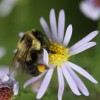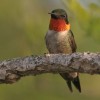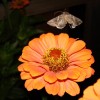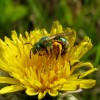Aster (Asteraceae)
Flodman's Thistle
Cirsium flodmanii (Rydb.) ArthurAlthough this native thistle spreads by rhizomes, it is not an aggressive species. Its flowers are a nectar and pollen source for many butterflies and bees. Male and female flowers occur on different plants, and insects must visit both for successful pollination. Birds often eat the seeds, or use the fluffy bristles to line their nests. These bristles also help the seeds move by floating on the wind.
Flower Colour:
- Purple
Flowering Season:
- Summer
- Fall
Flowering Months:
- August
- July
- June
- September
Canadian Rarity Status:
Not rare. Listed as “may be at risk” in Ontario and “exotic” in Quebec.
Physical Appearance:
The fuzzy, branching stem of this perennial grows 30 - 100 cm tall. Its alternate leaves have deep triangular lobes, sharp spines, fuzzy undersides, and get smaller up the stem. Flowering heads occur singly at the top of each branch, and are 2-3 cm high with numerous disc flowers. Green bracts with white stripes surround each rounded base. Fruiting heads consist of many achenes with a characteristic yellow band near their feathery bristles.
Similar Species:
Canada Thistle (Cirsium arvense (L.) Scop.), Wavy-leaved Thistle (Cirsium undulatum (Nutt.) Spreng.)
Gardening Notes:
Seeds and/or plants may be available from greenhouses and seed supply companies specializing in native plants.
Canadian Distribution:
- Alberta
- British Columbia
- Manitoba
- Ontario
- Quebec
- Saskatchewan
Prairie Types:
- Fescue Prairie
- Mixed Grass Prairie
- Tall Grass Prairie
Habitats:
- Meadows
- Prairies
- Railways
Moisture Conditions:
- Dry
- Moderate
- Moist
- Wet
Light Preference:
- Full Sun
Soil Preference:
- Clay
- Gravel
- Loam
- Sand









 Bumble, Honey, and other Bees (
Bumble, Honey, and other Bees ( Hummingbirds (
Hummingbirds ( Owlet Moths (
Owlet Moths ( Sweat Bees, Halictid Bees and other Bees (
Sweat Bees, Halictid Bees and other Bees (